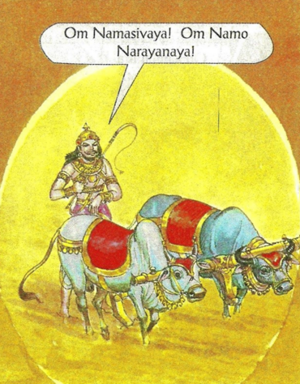Talk:Lunar Dynasty:Emperor Kuru
By Vishal Agarwal
King Kuru of the Puru–Bhārata dynasty ruled a prosperous kingdom along the banks of the sacred Sarasvatī River, located near the present-day border of Haryana and Punjab. One day, his aged prime minister sought permission to retire and settle in Vārāṇasī, on the banks of the Gaṅgā. When questioned, the minister explained, “Vārāṇasī is a holy city where Gaṅgā washes away sins. It is said that Bhagavān Śiva grants mokṣa to all who die there.”
The king pondered deeply and thought, “Why should my subjects have to travel so far for mokṣa? Is not Sarasvatī also a sacred river? How can I make my own kingdom as holy as Vārāṇasī?” He gathered his ministers for counsel, but most discouraged the idea, calling it impossible. Some advised him to seek guidance from the ṛṣis dwelling in the forests near Kurukṣetra.
When King Kuru approached the sages, they cautioned, “To make this land as sacred as Vārāṇasī is no easy task. You must pray to Śiva and Yama, the lord of death, for direction.” The king, undeterred, replied, “If Bhagīratha could bring the Gaṅgā down from heaven, I too can strive to make my land holy for the welfare of my people.”
According to Hindu dharm, all beings undergo countless cycles of birth and death, experiencing both joy and sorrow in each life. True freedom comes only by transcending this cycle and attaining union with Bhagavān, a state known as mokṣa, meaning liberation or release from suffering and rebirth.
Blessed by the sages, King Kuru devoted himself to intense worship and meditation on Śiva and Yama. Pleased by his determination, they appeared before him and offered him a boon. The king requested, “O Bhagavān, please lend me your bull Nandī, and O Yama, lend me your buffalo. I will till my land with these divine animals so that it becomes sacred.”
Śiva and Yama granted his request. The king became a farmer and began ploughing the plains of his realm with great devotion, continuously chanting, “Om Namaḥ Śivāya, Om Namo Nārāyaṇāya.”
For many years, King Kuru toiled tirelessly until the land was fully tilled. Then, he prayed to Bhagavān Viṣṇu for guidance. The deity appeared and said, “You have removed all impurities from this land through your labor. Now you must sow the seeds of dharm to make it truly holy. None is more righteous than you, King Kuru. Will you yourself become the seed to sanctify this land?”
King Kuru humbly replied, “Bhagavān, nothing would bring me greater joy than becoming the seed that makes my land holy and prosperous.”
Bhagavān Viṣṇu then transformed the king’s body into a heap of sacred grain and scattered the seeds across the fields. When the crops flourished, Viṣṇu summoned King Kuru’s soul and granted him a final boon. The king requested, “Please make this land as holy as Vārāṇasī, and let it be known henceforth as Kurukṣetra.” Viṣṇu granted his wish.
To this day, Kurukṣetra remains a revered pilgrimage site. Devotees visit its sacred ponds and perform ancestral rites there, believing that Bhagavān will bless the departed souls. In later times, Bhagavān Kṛṣṇa revealed the Bhagavad Gītā to his friend Arjuna on this very soil, further sanctifying Kurukṣetra.
The story of King Kuru teaches the virtue of selfless service and sacrifice. By dedicating his entire being for the welfare of his people, he exemplified the highest form of dharm, showing that through selfless action one earns both divine grace and immortality in Bhagavān.

